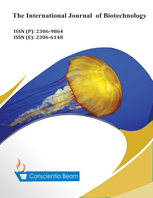Antibacterial Activity of Intracellular Greenly Fabricated Selenium Nanoparticle of Lactobacillus pentosus ADET MW861694 against Selected Food Pathogens
DOI:
https://doi.org/10.18488/journal.57.2021.101.39.51Abstract
This study aimed at intracellular biosynthesis of selenium nanoparticles using Lactobacillus pentosusADEB (LP) and the greenly fabricated nanoparticles were characterized based on visual observation, spectroscopy, microscopy, energy dispersive X-rays, X-ray Diffraction, and dynamic light scattering properties. The antibacterial activities of the Lactobacillus pentosusADEB selenium nanoparticles (LP-SeNPs) against selected foodborne pathogens were evaluated. A gradual change in colour from brown to reddish colour indicates the formation of Nano-selenium. The highest absorption peak for LP-SeNPs was visible between 200-300nm. FTIR analysis shows major peaks around 1635.40, 1587.31 2163.00, 2936.70, 2968.50, and 3254.38 cm-1 indicate the presence of amides on the nanoparticle surface. SEM and TEM analysis shows extrusion of spherical shape SeNPS from Lactobacillus pentosus cell membrane which indicates intracellular synthesis of the nanoparticles. The nanoparticles were crystalline with an average diameter of 106.1 nm and a polydispersity index of 0.295. Elemental selenium with an absorption peak at 1.37 Kev was present in the nanoparticles. The LP-SeNPs and culture of Lactobacillus pentosus had antagonistic activities against the foodborne pathogens. The LP-SeNPs have antagonistic activity against all the test pathogens. The highest activity was against Salmonella arizonae (11.3 mm). In conclusion, the intracellular greenly fabricated LP-SeNPs had broad-spectrum antagonistic activity against the test food-borne pathogens. The addition of selenium nanoparticles to food can be an added advantage in controlling food-borne pathogens.

